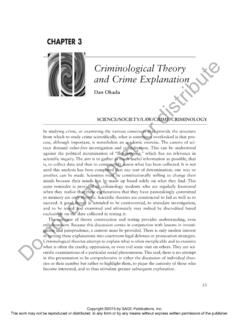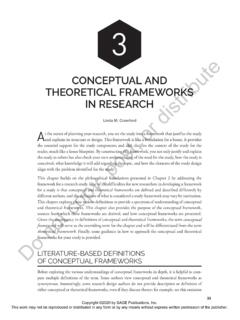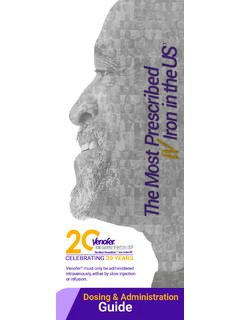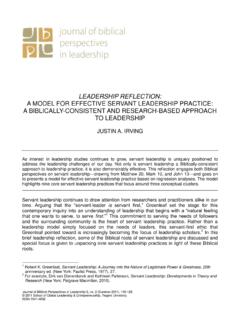Transcription of 1 Introduction: The Nature and Importance of Leadership
1 Everyone says there s a lack of Leadership in the world these days. I think we should all be thankful, because the only reason for Leadership is to convince people to do things that are either dangerous (like invading another country) or stupid ([like] working extra hard without extra pay).Obviously you don t need any Leadership to lead you to, for example, eat a warm cookie. But you need a lot of Leadership to convince you to march through a desert and shoot strangers. Generally speaking, whenever there is Leadership , there s lots of hollering and very few warm cookies. Let s enjoy the lack of lead-ership while we have Adams, Don t Step in the Leadership1 OVERVIEW vIn recent times the notion of Leadership has increasingly met with cynicism and become a hot topic for debate.
2 Despite a burgeoning but fragmented literature, there is no agreed paradigm so far for the study and practice of Leadership . vThis lack of consensus on what Leadership is together with a spate of high-profile failures due to poor or absent Leadership have proven to be contributory factors towards the cynicism that has since developed. vYet good Leadership that is both effective and moral has nevertheless been long recognized as crucial to human achievement and well-being. vThis chapter considers the multiplicity of definitions of Leadership and proposes an integrative and over-arching definition: Leadership is showing the way and helping or inducing others to pursue it. vLeadership is characterized by six core themes and their associated practices: envi-sioning a desirable future, promoting a clear purpose or mission, supportive values, intelligent strategies, and empowering and engaging all those concerned.
3 VLeadership effectiveness can be evaluated either in terms of behaviour the extent to which a leader helps or induces others to pursue a given way and purpose or mission or in terms of outcomes the extent to which a given desired future becomes a reality as a result of a leader s behaviour. This means that there are many different possible measures of Leadership according to the Nature of the envi-sioned future, purpose and context in which Leadership takes : The Nature and Importance of Leadership1(Continued)01-Gill 117/11/2011 11:08:36 AM2 Theory and Practice of Leadership vOne fruitful approach to understanding Leadership is to study followership: what fol-lowers expect of leaders and how leaders can satisfy these expectations.
4 VThe chapter compares and contrasts concepts of management and Leadership : we manage things and processes, but we lead people. vLeadership is about showing the way from where we are now to a desired place or state. Leadership , therefore, is about change and so we must explore the Leadership of change. vThe past emphasis on individual Leadership and command-and-control has been superseded by an emphasis today on shared and distributed Leadership and collec-tive Leadership capacity. An organization s collective Leadership capacity is the basis for a distinctive Leadership brand and its ability to is Leadership ?2 Every week, probably even every day, we can read a fresh new article or book that says: Effective Leadership is the key to success defined in terms of organizational and managerial effectiveness, financial results, or people s morale and happiness, or all of these.
5 When I entered Leadership into Google on 24 February 2011, I was pre-sented with about 176,000,000 entries. I then focused my curiosity and entered definition of Leadership . In of a second I was presented with a mere 59,100,000 I cannot claim that this introductory section in Chapter 1 is a comprehensive summary of the extant literature on the question What is Leadership ? But without reviewing all of it (to say the least), this is my humble attempt. After all, according to one Malaysian writer, theorizing about Leadership is great fun, hugely indulgent and largely useless (doing it instead, he says, is much more worthwhile).3 Nevertheless, my aim in the first part of this chapter is unapologetically to indulge in what hope-fully is an interesting if not fun account of how concepts and definitions of leader-ship agree and differ and the problems associated with this lack of consensus.
6 I then attempt a synthesis that reflects the essence of the etymology of the term that I hope will be defensible to scholars and useful to Concepts and Definitions of Leadership Agree and Differ: A Problem that Needs ResolvingWalter Friedman describes some of the earliest references to Leadership in American newspapers and books. He says, The term business Leadership appeared in newspapers only occasionally during [Andrew] Carnegie s heyday 4 ( , ). Popular books on Leadership started to appear from 1912 onwards. The British Academy of Management says: The subject of Leadership has created a plethora of publications, research and debate and has become a key issue in both the public and private sectors.
7 5 Today, Leadership is a hot topic for debate.(Continued)01-Gill 217/11/2011 11:08:37 AMIntroduction 3 The burgeoning Leadership literature ranges from highly cerebral academic research studies and scholarly treatises that few if any actual leaders will read to idio-syncratic personal prescriptions by self-acclaimed paragons of virtuous Leadership of how to be an outstanding leader at the popular end of the spectrum. Some of the contributions to the Leadership literature are both fictional and speculative:.. [divining] the dubious Leadership acumen of either long-dead military leaders [ Attila the Hun] of questionable reputation or fictional characters [such as Winnie the Pooh and Captain Picard of Star Trek] in order to proffer it to the masses as pearls of Roulet, a management consultant in the United States, feels that there is a surfeit of books, articles and discussion about Leadership , with much competing and confus-ing information in the public domain and that today s leaders seem to be getting worse instead of better.
8 7 And Joel Kurtzman says that .. a consensus has so far failed to emerge with respect to what Leadership is, how leaders develop, and perhaps most important how to become a more effective leader .8 One of the problems with Leadership studies, Robert Terry says, is that the subject has suffered from a lack of a common language .9 Victor Vroom of Yale University states, .. like many popular terms, [ Leadership ] has been used in many different ways .10 Perhaps Leadership is a Humpty Dumpty word:When I use a word, Humpty Dumpty said, in a rather scornful tone, it means just what I choose it to mean neither more nor less. The question is, said Alice, whether you can make words mean so many different things.
9 The question is, said Humpty Dumpty, which is to be master that s Winston and Kathleen Patterson, addressing the problem of the lack of consensus on what Leadership is, suggest, as I do, that the problem arises from studying the parts of Leadership rather than the This is what I mean when I suggest that those theories which are well known to academics and practitioners alike such as action-centred lead-ership, the managerial ( Leadership ) grid, situational Leadership and transformational/transactional Leadership (which we discuss in Chapter 3 on Leadership theories) are each individual pieces in the jigsaw puzzle that is Leadership . Winston and his team at regent University carried out an extensive review of the Leadership literature and produced 92 categories made up of over 1,000 constructs or statements relating to Leadership .
10 They distilled these into the following integrative definition of Leadership :A leader is one or more people who selects, equips, trains, and influences one or more follower(s) who have diverse gifts, abilities, and skills and focuses the follower(s) to the organization s mission and objectives causing the follower(s) to willingly and enthusiasti-cally expend spiritual, emotional, and physical energy in a concerted coordinated effort to achieve the organizational mission and definition then proceeds to describe how leaders do this. However this definition, while a heroic effort, is contentious in several ways. It has a top-down, 01-Gill 317/11/2011 11:08:38 AM4 Theory and Practice of Leadershipdirective tone that might be appropriate in some organizational and national cul-tures (see our discussion of culture in Chapter 6 on Leadership and values), but not as a universal definition.















